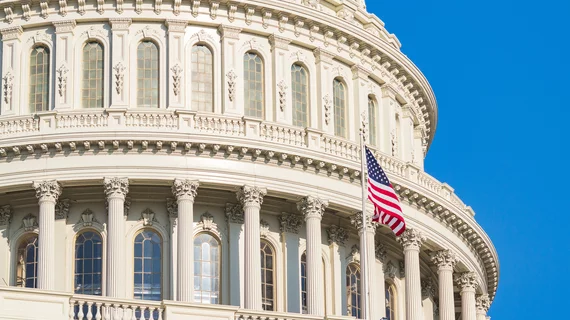Radiology business advocates’ top 5 priorities in Washington
The Radiology Business Management Association released its 2025 Advocacy Agenda on Tuesday with five key areas of focus in Washington.
RBMA, which represents over 2,100 professionals in the field, said it’s particularly concerned about cuts to radiologist reimbursement, workforce shortages, and “evolving healthcare policies” under a new administration. The organization believes radiology rests at a “crossroads,” with the “urgent need for action” to address some of the specialty’s biggest challenges.
“Without reform, the ripple effects of Medicare cuts and workforce shortages will compromise timely, accurate diagnoses that patients rely on,” Linda Wilgus, MBA, co-executive director of the RBMA, said in a statement shared Feb. 4. “Congress must act now to protect access to critical imaging services.”
Here’s a quick look at the association’s top five areas of focus. The list is not in order of importance, with Radiology Business adding the numbers for style:
1. Reforming Medicare reimbursement: A 2.83% cut to the conversion factor used to calculate physician payments took effect Jan. 1, despite attempts by RBMA and others to quash it. When factoring for inflation, radiologists and other physicians have seen Medicare pay fall 33% since 2001, the American Medical Association estimates.
Balanced-budget provisions mean that spending increases in one place necessitate reductions elsewhere. Namely, payment increases for primary care have led to reductions for radiologists and other physicians who don’t bill for evaluation and management codes.
“The current Medicare Physician Fee Schedule is a ticking time bomb for radiology, threatening patient access and the sustainability of practices nationwide,” RBMA said in a document detailing its priorities. “Decades of compounding cuts and budget neutrality constraints have pushed the field to a breaking point, forcing providers to do more with less—while patients pay the ultimate price in delayed diagnoses and compromised care. The Radiology Patient Action Network is leading the charge to demand reform, working alongside the RBMA to rally providers, patients, and policymakers against this systemic erosion.”
2. Addressing workforce shortages: “Understaffing is ubiquitous” in imaging, according to the most recent workforce survey from the RBMA and American College of Radiology. About 69% of radiologists surveyed said their organization is understaffed, up from 67% the previous year. Only 23% believe their workplace is fully manned, a drop from 25% in 2022.
“RBMA is actively encouraging legislative and regulatory policies that address these workforce issues including global recruitment of additional radiologists, supporting appropriate ordering of tests, and funding sources for additional residency slots,” the association said. “By advocating for supportive measures, RBMA aims to ensure a robust and well-prepared radiology workforce capable of meeting the evolving demands of healthcare.”
3. Educating policymakers: Radiology advocates believe that educating politicians about the specialty and its “critical role” can protect providers from funding cuts and other detrimental actions. Radiologists play a pivotal role in ensuring accurate diagnoses and treatment plans, which impacts numerous other specialties.
“Radiology’s role in preventative healthcare is invaluable, offering significant cost savings through the early identification and management of medical issues,” the association said. “Through targeted educational initiatives, RBMA seeks to elevate the visibility and appreciation of radiology's value in the healthcare ecosystem.”
4. Making virtual supervision permanent: Amid the COVID-19 pandemic, the Centers for Medicare & Medicaid Services started allowing providers to virtually oversee certain exams to help with staffing issues and slow the virus’s spread. However, the perk is only temporary, with CMS last extending it through 2025.
RBMA and others have advocated for making the policy change permanent, given its popularity.
“The COVID-19 pandemic highlighted the efficacy and necessity of virtual supervision of contrast studies, allowing radiologists to guide procedures and consultations remotely,” RBMA said. “Making this a permanent fixture will enhance flexibility, efficiency, and access to radiological expertise, particularly in underserved areas.”
5. Fixing the No Surprises Act: The landmark legislation took effect in 2022, protecting patients from unexpected bills that arise when they receive out-of-network care. However, three years later, the NSA remains plagued by unfair payment calculations and a “burdensome” process for resolving disputes.
Medicare has received over 16,000 grievances under the NSA. Top complaints against health plans have included issuing late reimbursement after disputes were resolved and failure to pony up within 30 days of determinations.
“To ensure fair reimbursement and reduce the operational burden on radiology practices, it is essential to address the issues of transparency, compliance with timelines, and the limitations on claim batching,” RBMA said. “By advocating for these changes, radiology practices can better navigate the complexities of the No Surprises Act and continue to provide high-quality diagnostic services to patients.”
You can find much more about the association’s 2025 Advocacy Agenda—including contact info, next steps, and how to get involved—here.

